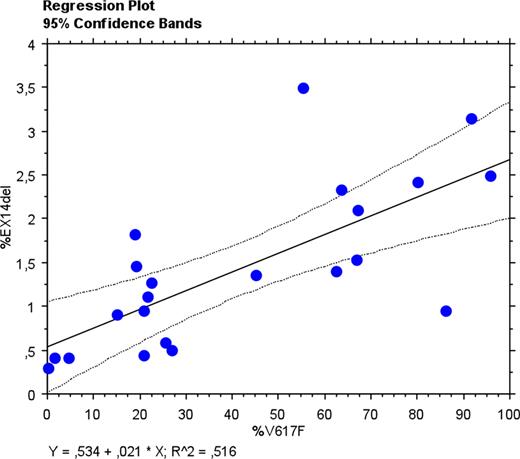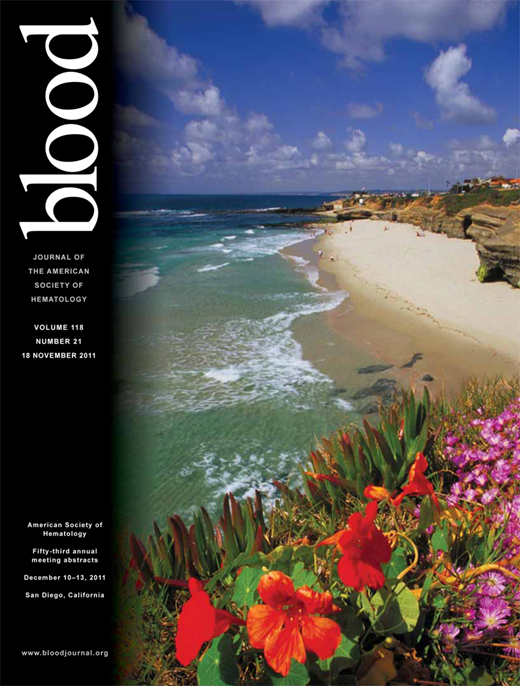Abstract
Abstract 3844
In recent years the diagnosis and treatment of patients with myeloproliferative disorders has focused on the JAK2 gene. Recently, an alternative splicing of JAK2 transcript lacking the entire exon 14 (88bp), has been described (Ma et al. (2010) PLoS ONE, 5, e12165). This mRNA has a stop codon in exon 15 and is translated into a truncated protein that has a deletion within the JH2 pseudokinase domain and complete deletion of the kinase domain (JH1). The alternative transcript was detected in plasma of patients with myeloproliferative neoplasms (MPNs) (58% of patients positive for the V617F mutation and 33% of negative) in proportions ranging from 2% to 26% compared to the normal transcript, but never in healthy subjects. However, quantification of the transcript was performed by quantitative fragment length analysis, which is not the most appropriate method for such determination especially if, as in this case, the PCR is not limited to the exponential phase (Cirigliano, V. et al. (2001) Mol. Hum. Reprod., 7, 1001–1006).
We investigate the mRNA levels of JAK2 and its splicing variant lacking exon 14, in granulocytes isolated from peripheral blood of 9 healthy individuals and 41 patients diagnosed with primary myelofibrosis (19 negative and 22 positive for the JAK2 V617F mutation). To overcome the limitations of quantitative fragment length analysis, the levels of the splice variant were assessed by qPCR, using a boundary-spanning primer designed on the junction between exons 13 and 15 (Vandenbroucke II, et al. (2001) Nucleic Acids Res., 29:E68). The JAK2 V617F allele burden was measured as previously described (Lippert, E. et al. (2006) Blood, 108, 1865–1867).
To explain this observation we performed a bioinformatic analysis of the exon 14 sequence, using the software Human Splice Finder 2.4.1 (Desmet, F.O. et al. (2009) Nucleic Acids Res37 (e67) and ESE finder 3.0 (Cartegni, L. et al. (2003) Nucleic Acids Res31 (13)). The G/T transversion causing the aminoacidic substitution V617F also breaks an high-score, putative, Exon Splicing Enhancer (ESE) sequence that potentially binds the splicing regulator protein SRP55 (TGTGTC; positions 70 to 75 of exon 14). The higher level of the splice variant found in patients with the mutation could be due to an alteration of the binding of molecular factors that determine the inclusion of exon 14 in mature transcripts. The low levels of alternative transcripts observed, could be due to the presence of a stop codon in exon 15 as a result of the frameshift caused by the exclusion of exon 14. We know that a stop codon at more than 55 bases upstream of the last exon junction (in this case between exons 24 and 25) determines the activation of the Nonsense Mediated mRNA Decay (NMD) system and the consequent destruction of the messenger. In order to knowhow a small percentage of mRNA, subjected to degradation by NMD system, can produce the predicted 70 KDa protein that has been detected after immunoprecipitation and western blot analysis using JAK2 N-terminal antibodies, we are characterizing the 3' end of the alternative transcript.
We show that the somatic mutation in exon 14 of JAK2 gene, in addition to the effects caused by the V617F amino acid change, has a moderate influence on splicing, increasing the levels of a splicing variant that is produced in small amounts also in healthy subjects. Our study demonstrates the efficacy of qPCR technique and the predictive power of bioinformatics tools used here. Further studies are needed to understand how this isoform is processed at the post-transcriptional level and whether there are significant effects on clinical phenotype.
Barosi:Novartis: Membership on an entity's Board of Directors or advisory committees.
Author notes
Asterisk with author names denotes non-ASH members.


